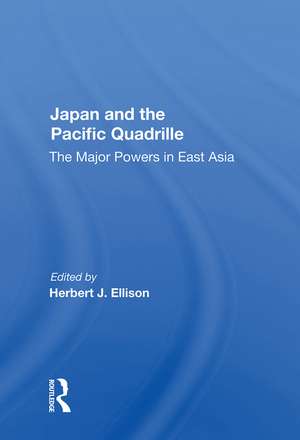Japan And The Pacific Quadrille: The Major Powers In East Asia
Editat de Herbert J. Ellisonen Limba Engleză Hardback – 7 iun 2019
Preț: 764.20 lei
Preț vechi: 1027.40 lei
-26% Nou
Puncte Express: 1146
Preț estimativ în valută:
146.25€ • 150.88$ • 123.78£
146.25€ • 150.88$ • 123.78£
Carte tipărită la comandă
Livrare economică 04-18 martie
Preluare comenzi: 021 569.72.76
Specificații
ISBN-13: 9780367013158
ISBN-10: 0367013150
Pagini: 152
Dimensiuni: 145 x 229 mm
Greutate: 0.45 kg
Ediția:1
Editura: Taylor & Francis
Colecția Routledge
Locul publicării:Oxford, United Kingdom
ISBN-10: 0367013150
Pagini: 152
Dimensiuni: 145 x 229 mm
Greutate: 0.45 kg
Ediția:1
Editura: Taylor & Francis
Colecția Routledge
Locul publicării:Oxford, United Kingdom
Cuprins
Introduction: Japan and the Pacific Quadrille -- Relations Between the Nations of the Pacific Quadrille: Stability and Fluctuation in East Asian Politics -- The Geopolitics of East and Southeast Asia -- An Economic Overview of East Asia -- Japan's Foreign Policy Background -- Japanese-Chinese Relations, 1952–1982 -- Japanese-Soviet Relations: Patterns and Prospects -- Japan and the United States in the 1980s: The Domestication of Foreign Policy -- Changing Conceptions of Japan's International Role -- The Pacific Quadrille Since 1983
Descriere
The relationships between Japan, China, the United States, and the Soviet Union–among the most important power relationships in the contemporary world–have undergone pervasive and dramatic transformation during the past 15 years. China emerged from diplomatic isolation and the convulsions of the Cultural Revolution to define a new course in domestic policy and to take an active role in Asia and the world. The Soviet Union has become a global superpower, having built a formidable new regional military and naval presence that challenges the security and interests of the other powers, testing regional alliance structures. The United States–initially the dominant power in the region–is facing increasing economic competition from Japan and military competition from the Soviet Union. Each of these changes has brought new opportunities for Japan, whose spectacular economic expansion was one of the major factors in the changing Asian power structure. None of the many complex questions about the modern Asian scene are more important than those concerning Japan's future policies: How will its new economic power be applied? how will it deal with the opportunity for a new relationship with China? and how will Soviet military expansion affect Japanese security policy, the vital issues of arms and Japan's security relationship with the United States in particular?
